Deck 3: Sensation and Perception
Question
Question
Question
Question
Question
Question
Question
Question
Question
Question
Question
Question
Question
Question
Question
Question
Question
Question
Question
Question
Question
Question
Question
Question
Question
Question
Question
Question
Question
Question
Question
Question
Question
Question
Question
Question
Question
Question
Question
Question
Question
Question
Question
Question
Question
Question
Question
Question
Question
Question
Question
Question
Question
Question
Question
Question
Question
Question
Question
Question
Question
Question
Question
Question
Question
Question
Question
Question
Question
Question
Question
Question
Question
Question
Question
Question
Question
Question
Question
Question

Unlock Deck
Sign up to unlock the cards in this deck!
Unlock Deck
Unlock Deck
1/545
Play
Full screen (f)
Deck 3: Sensation and Perception
1
The Chapter 3 prologue story was about a man named Mike May, who recovered partial vision in one eye after being completely blind for over 40 years. After regaining partialvision, how did Mike respond to the image shown below? 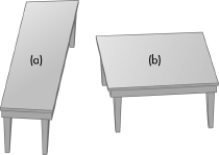
A)Unlike most people, Mike thought tabletop (b) was longer.
B)Like most people, Mike thought tabletop (a) was longer.
C)Mike thought the two tabletops were of identical size and shape.
D)Mike failed to perceive the separation between the two tables and saw the image as a misshaped "T."

A)Unlike most people, Mike thought tabletop (b) was longer.
B)Like most people, Mike thought tabletop (a) was longer.
C)Mike thought the two tabletops were of identical size and shape.
D)Mike failed to perceive the separation between the two tables and saw the image as a misshaped "T."
Mike thought the two tabletops were of identical size and shape.
2
The smallest possible difference between two stimuli whichcan be detected is called the:
A)difference threshold, or just noticeable difference.
B)transduction threshold.
C)the absolute threshold.
D)subliminal difference.
A)difference threshold, or just noticeable difference.
B)transduction threshold.
C)the absolute threshold.
D)subliminal difference.
difference threshold, or just noticeable difference.
3
If you perceive any 90-degree right angles in the cube depicted, it is because of the perceptual principle called: 
A)size constancy.
B)visual acuity.
C)the Müller-Lyer illusion.
D)shape constancy.

A)size constancy.
B)visual acuity.
C)the Müller-Lyer illusion.
D)shape constancy.
shape constancy.
4
When sensory receptors convert different forms of energy intoneural signals, the process is known as:
A)proprioception.
B)transduction.
C)sensory accommodation.
D)kinesthesis.
A)proprioception.
B)transduction.
C)sensory accommodation.
D)kinesthesis.

Unlock Deck
Unlock for access to all 545 flashcards in this deck.
Unlock Deck
k this deck
5
When Andrew had his hearing tested, some sounds were too soft for him to detect. These sounds were below his _____ for hearing.
A)difference threshold
B)absolute threshold
C)Weber's threshold
D)transduction threshold
A)difference threshold
B)absolute threshold
C)Weber's threshold
D)transduction threshold

Unlock Deck
Unlock for access to all 545 flashcards in this deck.
Unlock Deck
k this deck
6
In psychology, the term sensation formally refers to:
A)a vague feeling of excitement or pleasure.
B)the process of detecting a physical stimulus such as light, sound, heat, or pressure.
C)the transformation of physical energy into chemical energy.
D)the interpretation and organization of sensory stimuli.
A)a vague feeling of excitement or pleasure.
B)the process of detecting a physical stimulus such as light, sound, heat, or pressure.
C)the transformation of physical energy into chemical energy.
D)the interpretation and organization of sensory stimuli.

Unlock Deck
Unlock for access to all 545 flashcards in this deck.
Unlock Deck
k this deck
7
This image depicts a cross section of the human eye. Which structure contains the highest concentration of cones? 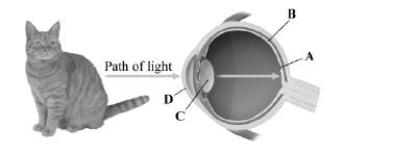
A)fovea
B)retina
C)lens
D)cornea

A)fovea
B)retina
C)lens
D)cornea

Unlock Deck
Unlock for access to all 545 flashcards in this deck.
Unlock Deck
k this deck
8
What perceptual principle allows you to perceive the image as either two faces or a vase? 
A)size constancy
B)linear perspective
C)the law of similarity
D)figure-ground reversal

A)size constancy
B)linear perspective
C)the law of similarity
D)figure-ground reversal

Unlock Deck
Unlock for access to all 545 flashcards in this deck.
Unlock Deck
k this deck
9
When you look at a photograph or artwork, you use a variety of visual cues to judge the distance of objects. The image depicts the author of your textbook and his daughter in EstesPark, Colorado. Which letter points to the visual cue of texture gradient? 

A)a
B)b
C)c
D)d


A)a
B)b
C)c
D)d

Unlock Deck
Unlock for access to all 545 flashcards in this deck.
Unlock Deck
k this deck
10
This image depicts the path that sound waves take through the human ear. Pick the alternative that correctly labels the structures in the drawing. 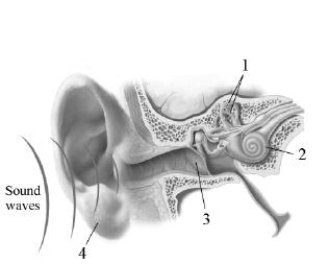
A)1 = cochlea, 2 = semicircular canals, 3 = pinna, 4 = oval window
B)1 = eardrum, 2 = pinna, 3 = eardrum, 4 = basilar membrane
C)1 = cochlea, 2 = semicircular canals, 3 = basilar membrane, 4 = eardrum
D)1 = semicircular canals, 2 = cochlea, 3 = eardrum, 4 = pinna

A)1 = cochlea, 2 = semicircular canals, 3 = pinna, 4 = oval window
B)1 = eardrum, 2 = pinna, 3 = eardrum, 4 = basilar membrane
C)1 = cochlea, 2 = semicircular canals, 3 = basilar membrane, 4 = eardrum
D)1 = semicircular canals, 2 = cochlea, 3 = eardrum, 4 = pinna

Unlock Deck
Unlock for access to all 545 flashcards in this deck.
Unlock Deck
k this deck
11
The diagram depicts key elements of the pain system. In which structure are A-delta fibers found? 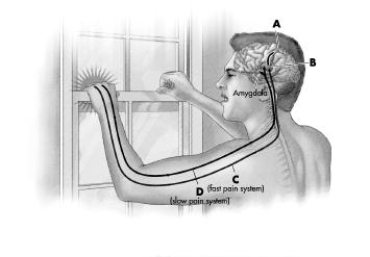
A)somatosensory cortex
B)thalamus
C)delta fibers (fast)
D)C fibers (slow)

A)somatosensory cortex
B)thalamus
C)delta fibers (fast)
D)C fibers (slow)

Unlock Deck
Unlock for access to all 545 flashcards in this deck.
Unlock Deck
k this deck
12
The smallest possible stimulus which can be detected half the time, or the minimum level of stimuli that we can detect, is called:
A)subliminal perception.
B)the absolute threshold.
C)the just noticeable difference, or difference threshold.
D)the perceptual threshold.
A)subliminal perception.
B)the absolute threshold.
C)the just noticeable difference, or difference threshold.
D)the perceptual threshold.

Unlock Deck
Unlock for access to all 545 flashcards in this deck.
Unlock Deck
k this deck
13
You catch the whiff of freshly popped popcorn as you enter the movie theater. The process by which the odor of popcorn is converted into neural signals that your brain can interpret as the smell of popcorn is called:
A)sensory adaptation.
B)proprioception
C)transduction.
D)accommodation.
A)sensory adaptation.
B)proprioception
C)transduction.
D)accommodation.

Unlock Deck
Unlock for access to all 545 flashcards in this deck.
Unlock Deck
k this deck
14
When you look at a photograph or artwork, you use a variety of visual cues to judge the distance of objects. The image depicts the author of your textbook and his daughter in EstesPark, Colorado. Which letter points to the visual cue of aerial perspective? 

A)a
B)b
C)c
D)d


A)a
B)b
C)c
D)d

Unlock Deck
Unlock for access to all 545 flashcards in this deck.
Unlock Deck
k this deck
15
When most people look at this image, they see the illusion of asolid white triangle. Which Gestalt principles are illustrated by this visual illusion? 
A)laws of proximity and contrast
B)laws of similarity and size constancy
C)laws of closure and good continuation
D)motion parallax and Gestalt priming

A)laws of proximity and contrast
B)laws of similarity and size constancy
C)laws of closure and good continuation
D)motion parallax and Gestalt priming

Unlock Deck
Unlock for access to all 545 flashcards in this deck.
Unlock Deck
k this deck
16
In contrast to sensation, the term perception is formally defined as the:
A)active mental process of integrating, organizing, and interpreting sensory data.
B)process of detecting a physical stimulus such as light, sound, heat, or pressure.
C)active mental process of understanding the meaning of a difficult new concept.
D)way in which different areas of the brain interact.
A)active mental process of integrating, organizing, and interpreting sensory data.
B)process of detecting a physical stimulus such as light, sound, heat, or pressure.
C)active mental process of understanding the meaning of a difficult new concept.
D)way in which different areas of the brain interact.

Unlock Deck
Unlock for access to all 545 flashcards in this deck.
Unlock Deck
k this deck
17
Sensation results when sensory receptor cells are stimulated by:
A)some form of physical energy.
B)substance P.
C)messages transmitted from the brain.
D)monocular cues.
A)some form of physical energy.
B)substance P.
C)messages transmitted from the brain.
D)monocular cues.

Unlock Deck
Unlock for access to all 545 flashcards in this deck.
Unlock Deck
k this deck
18
This image depicts the path that sound waves take through the human ear. Which letter indicates the structure that contains the hair cells? 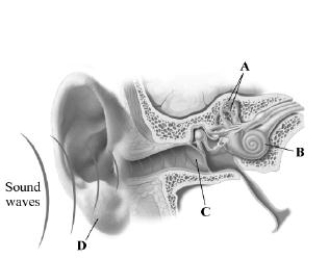
A)semicircular canals
B)cochlea
C)eardrum
D)pinna

A)semicircular canals
B)cochlea
C)eardrum
D)pinna

Unlock Deck
Unlock for access to all 545 flashcards in this deck.
Unlock Deck
k this deck
19
When you look at a photograph or art work, you use a variety of visual cues to judge the distance of objects. The image depicts the author of your textbook and his daughter in EstesPark, Colorado. Pick the alternative that correctly labels the monocular depth perception cues in the photograph. 

A)1 = linear perspective, 2 = binocular disparity, 3 = motion parallax, 4 = overlap
B)1 = texture gradient, 2 = linear perspective, 3 = overlap, 4 = aerial perspective
C)1 = relative size, 2 = texture gradient, 3 = aerial perspective, 4 = overlap
D)1 = linear perspective, 2 = texture gradient, 3 = overlap, 4 = convergence


A)1 = linear perspective, 2 = binocular disparity, 3 = motion parallax, 4 = overlap
B)1 = texture gradient, 2 = linear perspective, 3 = overlap, 4 = aerial perspective
C)1 = relative size, 2 = texture gradient, 3 = aerial perspective, 4 = overlap
D)1 = linear perspective, 2 = texture gradient, 3 = overlap, 4 = convergence

Unlock Deck
Unlock for access to all 545 flashcards in this deck.
Unlock Deck
k this deck
20
A large group of students were tested for their ability to distinguish among different tones. Although tone A and tone Bwere slightly different, more than half of the group thought that they sounded exactly the same. The difference between tone A and tone B can be said to be less than the:
A)difference threshold, or just noticeable difference.
B)absolute threshold, or average absolute threshold.
C)subliminal threshold.
D)Weber's threshold.
A)difference threshold, or just noticeable difference.
B)absolute threshold, or average absolute threshold.
C)subliminal threshold.
D)Weber's threshold.

Unlock Deck
Unlock for access to all 545 flashcards in this deck.
Unlock Deck
k this deck
21
The mere exposure effect refers to the:
A)view that the basilar membrane vibrates at the same frequency as the sound stimulus it is briefly exposed to.
B)fact that when people are repeatedly exposed to a novel stimulus, their liking for that particular stimulus will
C)de cproeinase.t at wInchoich a srrect tim ulus is strong enough to be detected because it activates sensory receptors after a brief exposure.
D)finding that repeated exposure to a particular stimulus leads to increased liking for that stimulus.
A)view that the basilar membrane vibrates at the same frequency as the sound stimulus it is briefly exposed to.
B)fact that when people are repeatedly exposed to a novel stimulus, their liking for that particular stimulus will
C)de cproeinase.t at wInchoich a srrect tim ulus is strong enough to be detected because it activates sensory receptors after a brief exposure.
D)finding that repeated exposure to a particular stimulus leads to increased liking for that stimulus.

Unlock Deck
Unlock for access to all 545 flashcards in this deck.
Unlock Deck
k this deck
22
By definition, stimuli that are perceived subliminally are:
A)accessible to conscious awareness.
B)inaccessible to conscious awareness.
C)effective motivators of consumer behavior.
D)ineffective motivators of consumer behavior.
A)accessible to conscious awareness.
B)inaccessible to conscious awareness.
C)effective motivators of consumer behavior.
D)ineffective motivators of consumer behavior.

Unlock Deck
Unlock for access to all 545 flashcards in this deck.
Unlock Deck
k this deck
23
The clear membrane that covers the outside of the eye and helps gather and direct incoming light is called the:
A)pupil.
B)cornea.
C)iris.
D)retina.
A)pupil.
B)cornea.
C)iris.
D)retina.

Unlock Deck
Unlock for access to all 545 flashcards in this deck.
Unlock Deck
k this deck
24
As you go to sleep at night, you realize that you can hear your roommate's wristwatch ticking. Out of curiosity, you keep arecord of when you hear the watch ticking and find out thatyou can hear it about half the time. Your ability to hear your roommate's wristwatch about half the time is an example of:
A)a difference threshold.
B)an absolute threshold.
C)Weber's law.
D)sensory adaptation.
A)a difference threshold.
B)an absolute threshold.
C)Weber's law.
D)sensory adaptation.

Unlock Deck
Unlock for access to all 545 flashcards in this deck.
Unlock Deck
k this deck
25
As the manager of a food store, your friend is trying to come up with ways of increasing sales of items that have a high profit margin. He decides that he is going to embed subliminal messages to buy certain items in the music that is playing in the store. What do you predict will happen to the sales of the items that are subliminally advertised?
A)There will be a significant increase in the sales of those subliminally advertised items.
B)There will be no real change in the sales of those subliminally advertised items.
C)There will be a significant decrease in the sales of those subliminally advertised items.
D)There will be a significant decrease in the sales of all items, whether they were subliminally advertised or not.
A)There will be a significant increase in the sales of those subliminally advertised items.
B)There will be no real change in the sales of those subliminally advertised items.
C)There will be a significant decrease in the sales of those subliminally advertised items.
D)There will be a significant decrease in the sales of all items, whether they were subliminally advertised or not.

Unlock Deck
Unlock for access to all 545 flashcards in this deck.
Unlock Deck
k this deck
26
Jill runs a hot bath. She starts to get into the tub but the waterfeels extremely hot. She stands in the hot water for a few moments, then slowly sits down, easing the rest of her bodyinto the water. After a few minutes, she feels quite comfortable; the water no longer feels too hot to her. This decline in sensitivity to a constant stimulus that Jill has experienced is called:
A)bottom-up processing.
B)sensory saturation.
C)sensory adaptation.
D)transduction.
A)bottom-up processing.
B)sensory saturation.
C)sensory adaptation.
D)transduction.

Unlock Deck
Unlock for access to all 545 flashcards in this deck.
Unlock Deck
k this deck
27
Recent research using subliminal perception has shown that:
A)faces paired with a pleasant subliminal odor received the highest likeability ratings, while faces paired with an unpleasant subliminal odor received the lowest ratings.
B)people are more strongly affected by subliminally presented product advertisements with odors than by regular advertisements without odors.
C)we tend to avoid products that are subliminally advertised, regardless of whether the subliminal advertisement is accompanied by pleasant or unpleasant odors.
D)faces paired with a pleasant subliminal odor received the lowest likeability ratings, while faces paired with an unpleasant subliminal odor received the highest ratings.
A)faces paired with a pleasant subliminal odor received the highest likeability ratings, while faces paired with an unpleasant subliminal odor received the lowest ratings.
B)people are more strongly affected by subliminally presented product advertisements with odors than by regular advertisements without odors.
C)we tend to avoid products that are subliminally advertised, regardless of whether the subliminal advertisement is accompanied by pleasant or unpleasant odors.
D)faces paired with a pleasant subliminal odor received the lowest likeability ratings, while faces paired with an unpleasant subliminal odor received the highest ratings.

Unlock Deck
Unlock for access to all 545 flashcards in this deck.
Unlock Deck
k this deck
28
According to _____, whether we can detect a change in the strength of a stimulus depends upon the intensity of the original stimulus.
A)the principle of sensory adaptation
B)the principle of absolute threshold
C)Weber's law
D)the principle of just noticeable difference
A)the principle of sensory adaptation
B)the principle of absolute threshold
C)Weber's law
D)the principle of just noticeable difference

Unlock Deck
Unlock for access to all 545 flashcards in this deck.
Unlock Deck
k this deck
29
The Science Versus Pseudoscience box "SubliminalPerception" described a study in which research participants sniffed pleasant, unpleasant, neutral, or no scent at all while viewing pictures of faces. Likeability ratings of faces were affected by scent when paired with scents that were:
A)pleasant and long-lasting.
B)pleasant but not consciously detected
C)noticeable but neutral.
D)briefly unpleasant.
A)pleasant and long-lasting.
B)pleasant but not consciously detected
C)noticeable but neutral.
D)briefly unpleasant.

Unlock Deck
Unlock for access to all 545 flashcards in this deck.
Unlock Deck
k this deck
30
Psychologists have found that the effects of subliminal stimulitend to be:
A)weak and short-lived.
B)weak but long-lasting.
C)fairly strong but short-lived.
D)fairly strong and long-lasting.
A)weak and short-lived.
B)weak but long-lasting.
C)fairly strong but short-lived.
D)fairly strong and long-lasting.

Unlock Deck
Unlock for access to all 545 flashcards in this deck.
Unlock Deck
k this deck
31
John puts one toe into the swimming pool and shivers because the water is so cold. He grits his teeth and dives in anyway.After about ten minutes, the temperature of the water seems quite comfortable to him. This example illustrates the principle of:
A)sensory difference.
B)just noticeable difference, or jnd.
C)accommodation.
D)sensory adaptation.
A)sensory difference.
B)just noticeable difference, or jnd.
C)accommodation.
D)sensory adaptation.

Unlock Deck
Unlock for access to all 545 flashcards in this deck.
Unlock Deck
k this deck
32
Viewing a subliminal image of the Israeli flag led Israeli research participants to express more _____ responses to political questions.
A)conservative
B)liberal
C)moderate
D)patriotic
A)conservative
B)liberal
C)moderate
D)patriotic

Unlock Deck
Unlock for access to all 545 flashcards in this deck.
Unlock Deck
k this deck
33
X-rays, radio waves, microwaves, and ultraviolet waves are allforms of _____ that differ in terms of their _____.
A)electromagnetic energy; absolute threshold
B)wavelengths; intensity
C)electromagnetic energy; wavelength
D)sensation; absolute threshold
A)electromagnetic energy; absolute threshold
B)wavelengths; intensity
C)electromagnetic energy; wavelength
D)sensation; absolute threshold

Unlock Deck
Unlock for access to all 545 flashcards in this deck.
Unlock Deck
k this deck
34
As you walk into an Indian restaurant, you immediately noticethe delicious odors of curry, saffron, and other spices. After afew minutes, however, you no longer notice the smell. This experience is an example of:
A)the mere exposure effect.
B)sensory adaptation.
C)anosmia.
D)Weber's law.
A)the mere exposure effect.
B)sensory adaptation.
C)anosmia.
D)Weber's law.

Unlock Deck
Unlock for access to all 545 flashcards in this deck.
Unlock Deck
k this deck
35
When you were younger, you probably had your hearing checked. Headphones were placed over your ears and you were to respond when you heard a sound. You were being tested for your hearing:
A)threshold.
B)sensory adaptation.
C)accommodation potential.
D)transduction.
A)threshold.
B)sensory adaptation.
C)accommodation potential.
D)transduction.

Unlock Deck
Unlock for access to all 545 flashcards in this deck.
Unlock Deck
k this deck
36
The mere exposure effect:
A)holds true for exposure to subliminal stimuli but not for exposure to nonsubliminal stimuli.
B)works when the particular stimulus presented is very familiar to the observer.
C)holds true for exposure to subliminal stimuli as well as exposure to nonsubliminal stimuli.
D)is another example of pseudoscience, much like subliminal perception.
A)holds true for exposure to subliminal stimuli but not for exposure to nonsubliminal stimuli.
B)works when the particular stimulus presented is very familiar to the observer.
C)holds true for exposure to subliminal stimuli as well as exposure to nonsubliminal stimuli.
D)is another example of pseudoscience, much like subliminal perception.

Unlock Deck
Unlock for access to all 545 flashcards in this deck.
Unlock Deck
k this deck
37
As you walk into a brightly lit room, the black structure in the center of your eye seems to shrink to a tiny black dot. This response is caused by the action of the eye structure called the:
A)cornea.
B)lens.
C)iris.
D)retina.
A)cornea.
B)lens.
C)iris.
D)retina.

Unlock Deck
Unlock for access to all 545 flashcards in this deck.
Unlock Deck
k this deck
38
The sensory receptor cells for vision are sensitive to what kind of stimulus?
A)light
B)heat
C)airborne molecules
D)chemical molecules
A)light
B)heat
C)airborne molecules
D)chemical molecules

Unlock Deck
Unlock for access to all 545 flashcards in this deck.
Unlock Deck
k this deck
39
As light waves enter the eye, which three structures do they pass through first?
A)pupil, iris, lens
B)cornea, iris, pupil
C)cornea, pupil, lens
D)fovea, iris, pupil
A)pupil, iris, lens
B)cornea, iris, pupil
C)cornea, pupil, lens
D)fovea, iris, pupil

Unlock Deck
Unlock for access to all 545 flashcards in this deck.
Unlock Deck
k this deck
40
When psychologists refer to the visible spectrum, they mean:
A)red, orange, and yellow light waves.
B)the visual field, including peripheral vision.
C)ultraviolet rays, gamma rays, and radio waves.
D)the narrow range of wavelengths in the electromagnetic spectrum that are visible to the human eye
A)red, orange, and yellow light waves.
B)the visual field, including peripheral vision.
C)ultraviolet rays, gamma rays, and radio waves.
D)the narrow range of wavelengths in the electromagnetic spectrum that are visible to the human eye

Unlock Deck
Unlock for access to all 545 flashcards in this deck.
Unlock Deck
k this deck
41
As you glance at the person sitting next to you in class, light reflected from the person's shirt first passes through which three structures of your eye?
A)pupil, iris, lens
B)cornea, iris, pupil
C)cornea, pupil, lens
D)fovea, iris, pupil
A)pupil, iris, lens
B)cornea, iris, pupil
C)cornea, pupil, lens
D)fovea, iris, pupil

Unlock Deck
Unlock for access to all 545 flashcards in this deck.
Unlock Deck
k this deck
42
Rods and cones are the:
A)sensory receptor cells for vision, found in the retina.
B)sensory receptor cells for hearing, found in the
C)coc tiny hlea.bon Inecs oforrec thte m iddle ear.
D)sensory receptor cells for taste, embedded in the taste buds.
A)sensory receptor cells for vision, found in the retina.
B)sensory receptor cells for hearing, found in the
C)coc tiny hlea.bon Inecs oforrec thte m iddle ear.
D)sensory receptor cells for taste, embedded in the taste buds.

Unlock Deck
Unlock for access to all 545 flashcards in this deck.
Unlock Deck
k this deck
43
Which of the following is(are) most involved with visual acuity?
A)rods
B)cones
C)bipolar cells
D)ganglion cells
A)rods
B)cones
C)bipolar cells
D)ganglion cells

Unlock Deck
Unlock for access to all 545 flashcards in this deck.
Unlock Deck
k this deck
44
Rods are used for vision in _____ light, and cones are used forvision in _____ light.
A)bright; dim
B)black; white
C)dim; bright
D)colorful; black and white
A)bright; dim
B)black; white
C)dim; bright
D)colorful; black and white

Unlock Deck
Unlock for access to all 545 flashcards in this deck.
Unlock Deck
k this deck
45
The sensory receptors for vision are:
A)found in the pupil.
B)the rods and cones of the retina.
C)found in the lens and cornea.
D)distributed throughout the inner eye.
A)found in the pupil.
B)the rods and cones of the retina.
C)found in the lens and cornea.
D)distributed throughout the inner eye.

Unlock Deck
Unlock for access to all 545 flashcards in this deck.
Unlock Deck
k this deck
46
Jake is nearsighted, and his cousin Janelle is farsighted. Their visual problems are caused by the fact that:
A)images are not properly focused on the retina.
B)the cornea is clouded due to age or disease.
C)the size of the blind spot has increased.
D)the pupil no longer dilates in dim light.
A)images are not properly focused on the retina.
B)the cornea is clouded due to age or disease.
C)the size of the blind spot has increased.
D)the pupil no longer dilates in dim light.

Unlock Deck
Unlock for access to all 545 flashcards in this deck.
Unlock Deck
k this deck
47
A common form of farsightedness occurs in middle age in which the lenses in the eyes become brittle and inflexible. This disorder is known as:
A)myopia.
B)astigmatism.
C)hyperopia.
D)presbyopia.
A)myopia.
B)astigmatism.
C)hyperopia.
D)presbyopia.

Unlock Deck
Unlock for access to all 545 flashcards in this deck.
Unlock Deck
k this deck
48
The blind spot is caused by:
A)diabetes.
B)the absence of rods or cones at the point where the optic
C)ne rmvealf leaveorms atthe eion ofye t.h (Te eruyeeb Answall.Inecr )Coorrecrrect t
D)degeneration of the optic nerve.
A)diabetes.
B)the absence of rods or cones at the point where the optic
C)ne rmvealf leaveorms atthe eion ofye t.h (Te eruyeeb Answall.Inecr )Coorrecrrect t
D)degeneration of the optic nerve.

Unlock Deck
Unlock for access to all 545 flashcards in this deck.
Unlock Deck
k this deck
49
What causes nearsightedness, farsightedness, and astigmatism?
A)The blind spot is abnormally large or small.
B)Incoming light signals are not properly focused on the retina.
C)The iris and cornea do not function properly.
D)Accommodation does not take place.
A)The blind spot is abnormally large or small.
B)Incoming light signals are not properly focused on the retina.
C)The iris and cornea do not function properly.
D)Accommodation does not take place.

Unlock Deck
Unlock for access to all 545 flashcards in this deck.
Unlock Deck
k this deck
50
The visual sensory receptor cells that transform light energyi nto a neural signal are the:
A)bipolar cells in the blind spot.
B)ganglion cells in the optic disk.
C)bipolar cells in the optic nerve.
D)rods and cones in the retina.
A)bipolar cells in the blind spot.
B)ganglion cells in the optic disk.
C)bipolar cells in the optic nerve.
D)rods and cones in the retina.

Unlock Deck
Unlock for access to all 545 flashcards in this deck.
Unlock Deck
k this deck
51
Identify the sequence that correctly represents the path taken by light signals through the eye.
A)lens, pupil, optic nerve, retina
B)cornea, pupil, lens, retina
C)cornea, lens, iris, retina
D)lens, iris, retina, pupil
A)lens, pupil, optic nerve, retina
B)cornea, pupil, lens, retina
C)cornea, lens, iris, retina
D)lens, iris, retina, pupil

Unlock Deck
Unlock for access to all 545 flashcards in this deck.
Unlock Deck
k this deck
52
In a condition called _____, a misshapen eyeball causes lightfrom distant objects to be focused at a point in front of the retina.
A)anosmia
B)hyperopia or farsightedness
C)astigmatism.
D)myopia or nearsightedness
A)anosmia
B)hyperopia or farsightedness
C)astigmatism.
D)myopia or nearsightedness

Unlock Deck
Unlock for access to all 545 flashcards in this deck.
Unlock Deck
k this deck
53
What happens when rods and cones are exposed to light?
A)They undergo accommodation.
B)They undergo a chemical reaction that results in a neural signal.
C)They become more light-sensitive and thus cause an increase in visual acuity.
D)They create problems with dark adaptation in the fovea.
A)They undergo accommodation.
B)They undergo a chemical reaction that results in a neural signal.
C)They become more light-sensitive and thus cause an increase in visual acuity.
D)They create problems with dark adaptation in the fovea.

Unlock Deck
Unlock for access to all 545 flashcards in this deck.
Unlock Deck
k this deck
54
Bob had perfect vision until he was 45, and then he needed tostart wearing glasses for reading. Most likely, Bob has developed a visual problem called:
A)presbyopia, caused by the lens of the eye losing its flexibility.
B)astigmatism, caused by a gradual shrinking of the eyeball.
C)myopia, caused by a thickening of the cornea.
D)hyperopia, caused by the eyeball becoming elongated.
A)presbyopia, caused by the lens of the eye losing its flexibility.
B)astigmatism, caused by a gradual shrinking of the eyeball.
C)myopia, caused by a thickening of the cornea.
D)hyperopia, caused by the eyeball becoming elongated.

Unlock Deck
Unlock for access to all 545 flashcards in this deck.
Unlock Deck
k this deck
55
The thin, light-sensitive membrane that lies at the back of the eye and contains the sensory receptors for light is the _____.
A)fovea
B)optic disk
C)retina
D)optic nerve
A)fovea
B)optic disk
C)retina
D)optic nerve

Unlock Deck
Unlock for access to all 545 flashcards in this deck.
Unlock Deck
k this deck
56
Ron's eyeball is abnormally shaped, and incoming light is focused at a point behind his retina. Ron wears glasses to correct this visual condition, which is called:
A)astigmatism.
B)myopia or nearsightedness.
C)anosmia or night blindness.
D)hyperopia or farsightedness.
A)astigmatism.
B)myopia or nearsightedness.
C)anosmia or night blindness.
D)hyperopia or farsightedness.

Unlock Deck
Unlock for access to all 545 flashcards in this deck.
Unlock Deck
k this deck
57
Each eye contains about _____ rods and about _____ cones.
A)7 million; 125 million
B)25; 200
C)1 million; 3 million
D)125 million; 7 million
A)7 million; 125 million
B)25; 200
C)1 million; 3 million
D)125 million; 7 million

Unlock Deck
Unlock for access to all 545 flashcards in this deck.
Unlock Deck
k this deck
58
In _____, an abnormally curved eyeball results in blurry vision for lines in a particular direction.
A)presbyopia
B)astigmatism
C)myopia
D)hyperopia
A)presbyopia
B)astigmatism
C)myopia
D)hyperopia

Unlock Deck
Unlock for access to all 545 flashcards in this deck.
Unlock Deck
k this deck
59
Both Myra and Ben have worn glasses since they were children, but Myra is extremely nearsighted, and Ben is extremely farsighted. Both Myra and Ben have:
A)abnormally shaped eyeballs.
B)abnormally shaped retinas.
C)malfunctioning cones.
D)malfunctioning bipolar cells.
A)abnormally shaped eyeballs.
B)abnormally shaped retinas.
C)malfunctioning cones.
D)malfunctioning bipolar cells.

Unlock Deck
Unlock for access to all 545 flashcards in this deck.
Unlock Deck
k this deck
60
The _____ thickens or thins to focus incoming light. This process is called _____.
A)lens; accommodation
B)iris; sensory adaptation
C)pupil; accommodation
D)pupil; sensory adaptation
A)lens; accommodation
B)iris; sensory adaptation
C)pupil; accommodation
D)pupil; sensory adaptation

Unlock Deck
Unlock for access to all 545 flashcards in this deck.
Unlock Deck
k this deck
61
We have a blind spot in our field of vision, but we ordinarily don't notice it. What "fills in" the missing visual information?
A)bipolar cells
B)optic disk
C)ganglion cells
D)the brain
A)bipolar cells
B)optic disk
C)ganglion cells
D)the brain

Unlock Deck
Unlock for access to all 545 flashcards in this deck.
Unlock Deck
k this deck
62
A ganglion cell might receive information from a hundred_____, but from only one or two _____.
A)rods; cones
B)cones; rods
C)bipolar cells; retinal spots
D)bipolar cells; corneal cells
A)rods; cones
B)cones; rods
C)bipolar cells; retinal spots
D)bipolar cells; corneal cells

Unlock Deck
Unlock for access to all 545 flashcards in this deck.
Unlock Deck
k this deck
63
Rods are to cones as _____ is(are) to _____.
A)peripheral vision and night vision; color vision and visual acuity
B)color vision and night vision; bright light conditions
C)bipolar cells; ganglion cells
D)color vision and visual acuity; peripheral vision and night vision
A)peripheral vision and night vision; color vision and visual acuity
B)color vision and night vision; bright light conditions
C)bipolar cells; ganglion cells
D)color vision and visual acuity; peripheral vision and night vision

Unlock Deck
Unlock for access to all 545 flashcards in this deck.
Unlock Deck
k this deck
64
From the optic chiasm, the PRIMARY visual pathway projects first to the _____ and processes information about_____.
A)midbrain; location of objects
B)thalamus; form, color, brightness, and depth of objects
C)temporal lobe; movement, speed, and direction of objects
D)optic disk; shape, size, and distance of objects
A)midbrain; location of objects
B)thalamus; form, color, brightness, and depth of objects
C)temporal lobe; movement, speed, and direction of objects
D)optic disk; shape, size, and distance of objects

Unlock Deck
Unlock for access to all 545 flashcards in this deck.
Unlock Deck
k this deck
65
The _____ developed from brain tissue and combine, analyze,and encode visual information in the retina.
A)ganglion cells
B)bipolar cells
C)cones
D)trichromatic cells
A)ganglion cells
B)bipolar cells
C)cones
D)trichromatic cells

Unlock Deck
Unlock for access to all 545 flashcards in this deck.
Unlock Deck
k this deck
66
Information from the rods and cones is first collected by which type of specialized neuron?
A)ganglion cells
B)blind spot cells
C)bipolar cells
D)corneal cells
A)ganglion cells
B)blind spot cells
C)bipolar cells
D)corneal cells

Unlock Deck
Unlock for access to all 545 flashcards in this deck.
Unlock Deck
k this deck
67
Cones are most concentrated in the:
A)periphery of the eye.
B)optic disk.
C)optic chiasm.
D)fovea.
A)periphery of the eye.
B)optic disk.
C)optic chiasm.
D)fovea.

Unlock Deck
Unlock for access to all 545 flashcards in this deck.
Unlock Deck
k this deck
68
Axons from the _____ are bundled together to form the _____.
A)bipolar cells; optic chiasm
B)photoreceptors; optic nerve
C)rods and cones; optic chiasm
D)ganglion cells; optic nerve
A)bipolar cells; optic chiasm
B)photoreceptors; optic nerve
C)rods and cones; optic chiasm
D)ganglion cells; optic nerve

Unlock Deck
Unlock for access to all 545 flashcards in this deck.
Unlock Deck
k this deck
69
What is the optic disk?
A)a tiny spot in the center of the fovea where there is a high concentration of rods and cones
B)the portion of the lens which focuses incoming light
C)the point at which the optic nerve fibers leave the back of the eye
D)a transparent membrane which lies just behind the pupil of the eye and that helps funnel light waves to the lens and retina
A)a tiny spot in the center of the fovea where there is a high concentration of rods and cones
B)the portion of the lens which focuses incoming light
C)the point at which the optic nerve fibers leave the back of the eye
D)a transparent membrane which lies just behind the pupil of the eye and that helps funnel light waves to the lens and retina

Unlock Deck
Unlock for access to all 545 flashcards in this deck.
Unlock Deck
k this deck
70
The optic chiasm is the:
A)junction of the ganglion and bipolar cells.
B)point at which the optic nerve fibers from each eye meet and cross over to opposite sides of the brain
C)point in the visual field at which peripheral vision begins.
D)place where the optic nerve exits the back of the eye, causing a blind spot or gap in vision.
A)junction of the ganglion and bipolar cells.
B)point at which the optic nerve fibers from each eye meet and cross over to opposite sides of the brain
C)point in the visual field at which peripheral vision begins.
D)place where the optic nerve exits the back of the eye, causing a blind spot or gap in vision.

Unlock Deck
Unlock for access to all 545 flashcards in this deck.
Unlock Deck
k this deck
71
The brain receives less detailed information from the _____than from the _____.
A)lens; cones
B)cones; rods
C)rods; cones
D)cones; lens
A)lens; cones
B)cones; rods
C)rods; cones
D)cones; lens

Unlock Deck
Unlock for access to all 545 flashcards in this deck.
Unlock Deck
k this deck
72
Visual acuity is highest when images are focused on the fovea because of the high concentration of _____ in that region.
A)rods
B)bipolar cells
C)cones
D)peripheral cells
A)rods
B)bipolar cells
C)cones
D)peripheral cells

Unlock Deck
Unlock for access to all 545 flashcards in this deck.
Unlock Deck
k this deck
73
What region of the eye has the largest concentration of cones?
A)the periphery
B)the iris
C)the optic nerve
D)the fovea
A)the periphery
B)the iris
C)the optic nerve
D)the fovea

Unlock Deck
Unlock for access to all 545 flashcards in this deck.
Unlock Deck
k this deck
74
The SECONDARY visual pathway projects first to the _____and processes information about _____.
A)midbrain; location of objects
B)thalamus; form, color, brightness, and depth of objects
C)parietal lobe; movement, speed, and direction of objects
D)optic disk; shape, size, and distance of objects
A)midbrain; location of objects
B)thalamus; form, color, brightness, and depth of objects
C)parietal lobe; movement, speed, and direction of objects
D)optic disk; shape, size, and distance of objects

Unlock Deck
Unlock for access to all 545 flashcards in this deck.
Unlock Deck
k this deck
75
What does the optic disk cause?
A)color vision
B)night vision
C)blind spot
D)light adaptation
A)color vision
B)night vision
C)blind spot
D)light adaptation

Unlock Deck
Unlock for access to all 545 flashcards in this deck.
Unlock Deck
k this deck
76
Each _____ cell receives information from its receptive field,which _____.
A)bipolar; consists of rods but not cones
B)ganglion; is a particular area of the retina
C)ganglion; is a particular area of the iris
D)bipolar; consists of the rods and cones that connect to that bipolar cell
A)bipolar; consists of rods but not cones
B)ganglion; is a particular area of the retina
C)ganglion; is a particular area of the iris
D)bipolar; consists of the rods and cones that connect to that bipolar cell

Unlock Deck
Unlock for access to all 545 flashcards in this deck.
Unlock Deck
k this deck
77
Which type of sensory receptors are involved in color vision?
A)trichromatic cells
B)cones but not rods
C)rods but not cones
D)both rods and cones
A)trichromatic cells
B)cones but not rods
C)rods but not cones
D)both rods and cones

Unlock Deck
Unlock for access to all 545 flashcards in this deck.
Unlock Deck
k this deck
78
The blind spot:
A)increases in size with age.
B)is caused by nearsightedness.
C)is a small gap in our field of vision.
D)can be cured with laser surgery.
A)increases in size with age.
B)is caused by nearsightedness.
C)is a small gap in our field of vision.
D)can be cured with laser surgery.

Unlock Deck
Unlock for access to all 545 flashcards in this deck.
Unlock Deck
k this deck
79
From the optic chiasm, visual information travels first to the_____.
A)olfactory bulb
B)thalamus
C)primary visual cortex
D)hypothalamus
A)olfactory bulb
B)thalamus
C)primary visual cortex
D)hypothalamus

Unlock Deck
Unlock for access to all 545 flashcards in this deck.
Unlock Deck
k this deck
80
Your friend shows you an old coin that he found in his great-grandfather's attic. To examine it, you instinctively bring thecoin close to your eye and to the very center of your visual field. Why?
A)Visual acuity is highest in the region with the largest concentration of rods, which is the fovea at the very center of the eye.
B)Visual acuity is highest in the region with the largest concentration of cones, which is the fovea at the very center of the eye.
C)You want to avoid focusing the image on your blind spot.
D)You need to avoid focusing the image on the optic disk.
A)Visual acuity is highest in the region with the largest concentration of rods, which is the fovea at the very center of the eye.
B)Visual acuity is highest in the region with the largest concentration of cones, which is the fovea at the very center of the eye.
C)You want to avoid focusing the image on your blind spot.
D)You need to avoid focusing the image on the optic disk.

Unlock Deck
Unlock for access to all 545 flashcards in this deck.
Unlock Deck
k this deck



